
19 minute read
Dance gift from the Yunek family
Department of Dance receives gift from the Yunek family Donation will support annual choreographic residency program at KSU Dance
By Kathie Beckett
Kennesaw State University Department of Dance has received a donation of $541,000 from the Yunek family.

The Eleo Pomare–Glenn Conner Dance Endowment will be used to begin the KSU Choreographic Residency Program to bring two nationally curated choreographers to the Department of Dance each summer to create two world premieres. The annual choreographic residency honors the late benefactors who were luminaries of the dance world.
The gift from Jay and Debra Yunek, the Eleo Pomare–Glenn Conner Dance Endowment, honors their late uncle, Glenn Conner, and his partner and choreographer Eleo Pomare. Pomare, who passed away in 2008, was known for developing innovative choreography that deals with social inequality and injustice. The funds will be used to promote and preserve Pomare’s legacy through the cultivation of new choreographic voices. Ivan Pulinkala, dean of the College of the Arts and the founder of KSU Dance, announced the major gift at the opening of the student dance performance “Slang” at the KSU Dance Theater in Marietta.
“We are grateful to the Yunek’s for their generous donation to KSU Dance in honor of Glenn and Eleo,” said Pulinkala. “The KSU Choreographic Residency will help support the careers of emerging choreographers nationally and give our students a unique experience of collaborating with professionals in the field.”
Combined with a previous gift received in 2018, the Yunek family has given almost $1 million to support dance at KSU.
Through the generosity of the Yunek family, emerging choreographers will have the opportunity to develop their unique artistic voice. The KSU Choreographic Residency Program will provide each chosen choreographer with a $6,000 honorarium to support their housing, travel and living expenses during the four-week residency and performance, as well as a budget to produce an original choreographic work.
KSU Dance will create a summer course in which students accepted by audition will have the opportunity to work with one of the nationally curated choreographers. Both works will be produced at the end of the summer in the state-of-the-art KSU Dance Theater, allowing the choreographer to premiere his or her work and create a promotional video for future commissioning purposes.
A screening committee of university and community professionals will annually review the work of emerging choreographers from a national pool of applicants to select two individuals for the four-week KSU Choreographic Residency Program. •
Kennesaw State University’s (KSU) School of Art and Design (SOAAD) has experienced tremendous growth in enrollment over the last several years, and as a result, SOAAD was out of space. With the support of the College of the Arts and Kennesaw State, SOAAD began renovating a massive 21,000-square-foot facility at Chastain Pointe in October 2019 to give art and design students more space to work and study. On track to open in fall 2020, the Chastain Pointe facility will feature an impressive number of large studios and workspaces, along with additional faculty and administrative offices. Director of SOAAD and Professor of Art Geo Sipp has been overseeing the renovations and is very impressed with the work done so far. “The studios will have suspended ceiling panels, and the space will maintain a very industrial aesthetic, with ductwork and the decking visible,” says Sipp. By Lauren Richmond and Kathie Beckett
Of the 21,000-square-feet space, only 1,000 square feet will be used for such items as electrical equipment, leaving ample room for students to create and learn. Major studio spaces include four drawing and painting studios and a printmaking studio, including dedicated areas for different techniques utilized by printmaking students. understand these other disciplines to be a wellrounded illustrator or animator.” This merging of these distinct areas of art, fine art and applied art sets SOAAD students up for success after graduation. Sipp explains, “It’s all about image development and image content—so you learn these skills and it makes you a better professional in these other disciplines. What we have done is really focused on the marriage of fine and applied arts, and I think that makes us really unique.”
Many pieces of equipment, including antique printing presses, will be on display and be available for use by printmaking students. “We have so many printmaking materials,” according to Sipp, “and, right now, so many pieces of equipment that are in storage are state-of-the-art printmaking equipment. We’re going to be the best print facility in the South.” The facility will also boast a papermaking studio, a small computer lab and conference room, plus ample open study spaces. Several faculty offices and an administrative office will help give the growing faculty and staff some breathing room. While the new facility will primarily house drawing, painting, and printmaking spaces, all art and design students will benefit from this facility. “We are a very pluralistic program where fine and applied arts inform each other,” according to Sipp. “For example, animation and illustration students have to take figure drawing, advanced figure drawing; they have to take painting, they have to take printmaking. It’s essential to here in 2014, we had around 400, and it’s simply because the faculty and staff supported our ideas that the applied arts would draw students.” Sipp and the School have seen ample support from both COTA and KSU as a whole with the expansion of their programs and facilities as well. “KSU, as such a young institution,” remarks Sipp, “has been supportive of the interesting ways of devising programs and putting programs out there. We have a really unique institution here, and the School of Art and Design is positioned well.” • School of Art and Design’s Chris Dziejowski examines the plumbing trench lines in the warehouse.

Above, Chris Dziejowski examines the plumbing trench lines in the warehouse.
Although it’s been a tight squeeze in the current SOAAD facilities, the faculty and staff of the school are excited to see such growth. “Students are voting with their feet,” say Sipp. “They’re coming to KSU specifically because we offer these five disciplines. KSU’s programs are gaining students rapidly. We now have approximately 1100 students in art and design. When I came
New art facility on the way for School of Art and Design


Photo, above: L’Oréal Roaché as Ella and Alex Harding as Prince Char. Photo, Left: L’Oréal Roaché as Ella.
KSU Theatre students, alumni star in “Ella Enchanted” Cinderella gets an update at Synchronicity Theatre
By Kathie Beckett
Kennesaw State University’s Department of Theatre and Performance Studies’ (TPS) students and alumni helped make the magic of the holidays last a little longer with their roles in “Ella Enchanted” at Synchronicity Theatre. TPS senior L’Oreal Roache, who led in KSU productions over the fall semester, landed her first professional role as the title character of the musical “Ella Enchanted.” TPS junior Alex Harding also took on his first professional leading role as Prince Char. TPS alumni Amy Reynolds (Lucinda) and Meg Harkins (Hattie) also co-starred in this fantastical production, while TPS faculty member Amanda Wansa Morgan led the music direction and sound design, helping to create the magical fairy-tale world for the audience.
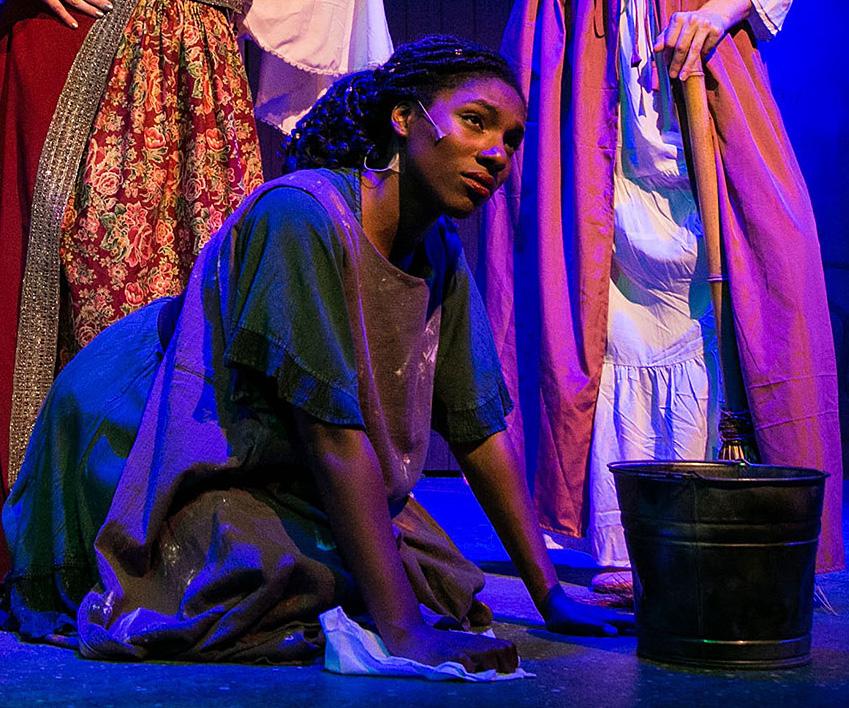
“Ella Enchanted” is a family-oriented musical based on the Newbery Award-winning young adult novel by Gail Carson Levine and adapted for the stage by Karen Zacarias. Filled with whimsical musical numbers, colorful characters, and a heap of humor, this retelling of the classic fairy-tale “Cinderella” also sets out to turn stereotypical female roles on its head by giving young girls a new kind of fairytale character to look up to: Ella, a strong, smart, and ambitious young girl who tackles her own problems and sets her own boundaries.
Audience members are entranced by the bewitching story of Ella, who was inadvertently cursed at birth by a young fairy named Lucinda and forced into a life of compelled obedience forever. Told this is a “gift,” Ella spends all her life involuntarily serving the people around her. After her mother dies, Ella breaks free and sets out on a quest for her freedom from this “gift,” certain that this curse was not the life she was meant to lead. She travels through a magical world of elves, gnomes, and giants in search of her fairy godmother, Lucinda, to reverse the curse placed on her all those years ago. She faces many challenges along the way while making new friends and finding her voice and independence.•

KSU Department of Dance presents “Moon Dust”
Work features two world premieres by Lisa K. Lock and Ivan Pulinkala
By Kathie Beckett
Kennesaw State University’s Department of Dance presented “Moon Dust” in early spring 2020. The performance included two world premieres: “Moon Dust,” choreographed by Ivan Pulinkala, dean of the College of the Arts, in collaboration with the College of Computing and Software Engineering, and “Bones,” choreographed by assistant professor of dance Lisa K. Lock.
A choreographer, performer and professor, Lock’s work “Bones” is physically driven by exploring manipulations of bones. “Bones are the structures that hold us upright, shape our appearances, and tell our histories,” explains Lock. “The performers evolve as they discover the sameness of an inner structure, which allows for trust, support, and individuality.”

[Continued to page 31.]
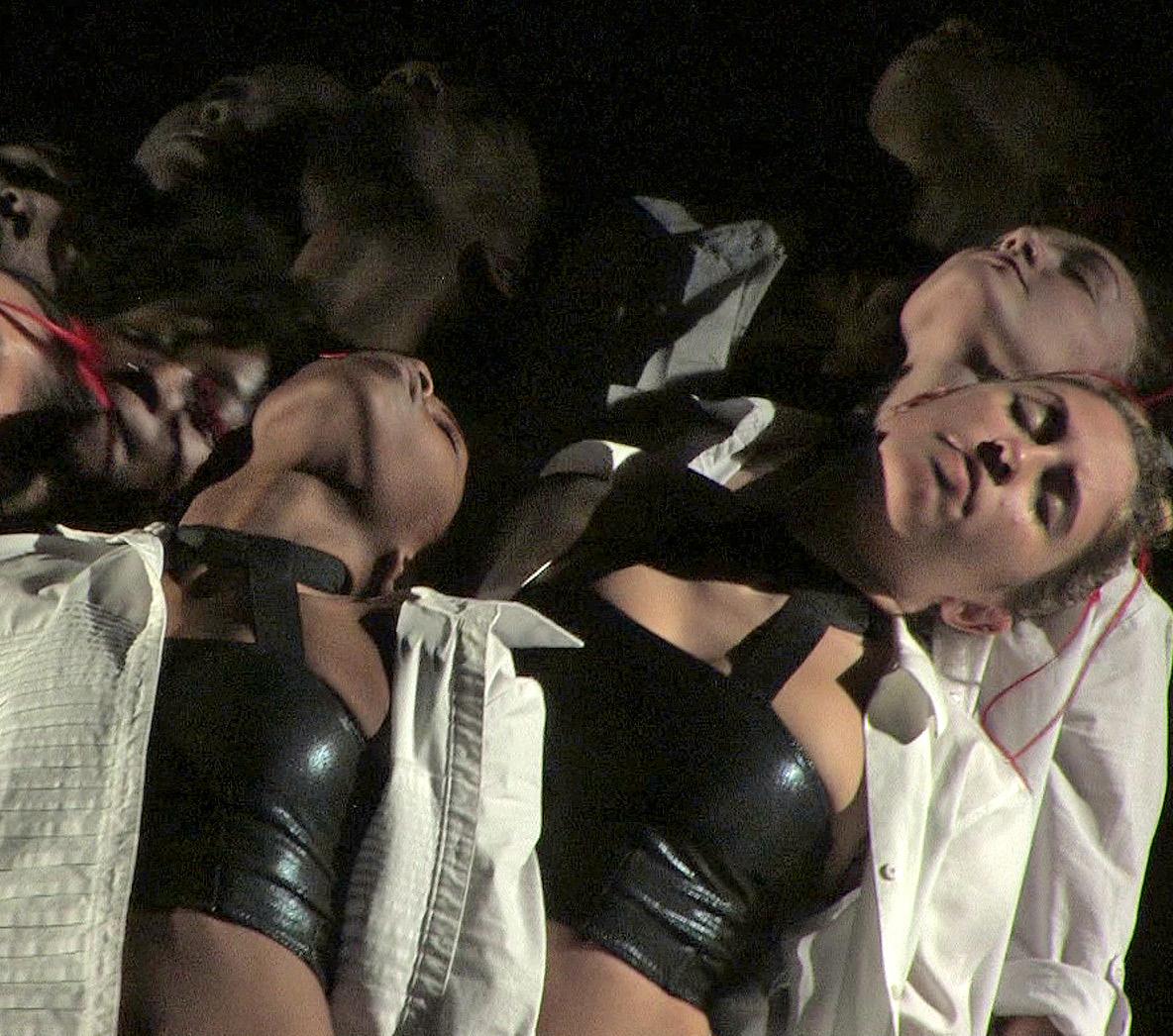
“Creativity spans all disciplines, and this dance production shows what we can accomplish when we work with others who come to a project with different perspectives,” said Jon Preston, dean of the College of Computing and Software Engineering.
[Continued from page 29.]
Next, patrons left the physical body behind and explored the journey of the human spirit as it transitions between life and an afterlife in “Moon Dust.” Pulinkala’s work is based on his research on the phenomenon of near-death experiences. Advances in medical sciences have resulted in a growing population of individuals who have been resuscitated from near-death events. Often, these individuals narrate vivid descriptions of their out-of-body experiences and their journey into the realms of an afterlife.
Through “Moon Dust,” Pulinkala metaphorically explored the journey of soulmates through life into an afterlife, using visually stunning effects developed through a collaboration with dean Jon Preston and designer Jaylin Gillam from KSU’s College of Computing and Software Engineering. Preston said, “The ‘Moon Dust’ collaboration is an excellent example of the interdisciplinary opportunities at KSU. Creativity spans all disciplines, and this dance production shows what we can accomplish when we work with others who come to a project with different perspectives. Certainly, computing and software engineering students and faculty have benefitted greatly by working with arts faculty and students.”
The production was unlike anything ever produced at KSU. Pulinkala visually altered the audience experience by using a screen that covered the entire front proscenium. At times, the screen was used as a projection surface that interacted with the choreography. A cast of 15 KSU dance majors presented this visually gratifying and physically demanding work through Pulinkala’s uniquely sophisticated choreographic vocabulary. The journey of soulmates was explored through a series of duets culminating in a defining male pas de deux that anchored the work and gave it a strong emotional charge.
With lighting design by Jordan Wardach, an alumna of KSU’s Department of Theatre and Performance Studies who now serves as the manager of the KSU Dance Theater, and costume design by Jill Peterson, “Moon Dust” took audiences into a supernatural world of visual imagination and left them reflecting on their own spiritual journeys with soulmates, some of whom are fortunate to have in this life. •

By Kathie Beckett
In a unique collaboration, the School of Art and Design’s Zuckerman Museum of Art and Clark Atlanta University Art Museum combined forces for the inaugural Tina Dunkley Fellow exhibitions in spring 2020 at the Zuckerman Museum of Art, located on the Kennesaw campus of Kennesaw State University. The Bernard A. Zuckerman Museum of Art’s (ZMA) new exhibitions “UNBOUND,” curated by Tina Dunkley Fellow Nzinga Simmons and “Looming Chaos,” curated by Tina Dunkley Fellow TK Smith, approach abstraction and its utility in interrogating identity, politics, and artistic expression. The exhibitions are the cumulative project of the inaugural Tina Dunkley Curatorial Fellows. This multi-institutional, cross-regional curatorial fellowship is a collaborative project between Clark Atlanta University Art Museum (CAUAM), the Zuckerman Museum of Art (ZMA), and the Pennsylvania Academy of the Fine Arts (PAFA). Created by Dr. Maurita Poole (CAUAM), the late Justin Rabideau (ZMA), and Brooke Davis Anderson (PAFA), the fellowship is meant to foster the next generation of museum professionals. “UNBOUND” brings together a multigenerational group of artists whose work takes an inventive and experimental approach to abstraction. Their works consider the essential elements of abstract painting: color, form, gesture, line, and space, through unorthodox use of materials that break the confines of a rectangular canvas, and implode the boundaries between painting, sculpture, and installation. The works on view hang, stretch, tether, and dangle off the walls, breaking free from the bounds of figuration, and complicating the boundaries of painting itself. “UNBOUND” features the works of Romare Bearden, Sam Gilliam, Joe Overstreet, Eric N. Mack, Anthony Akinbola, Krista Clark, and Tariku Shiferaw.

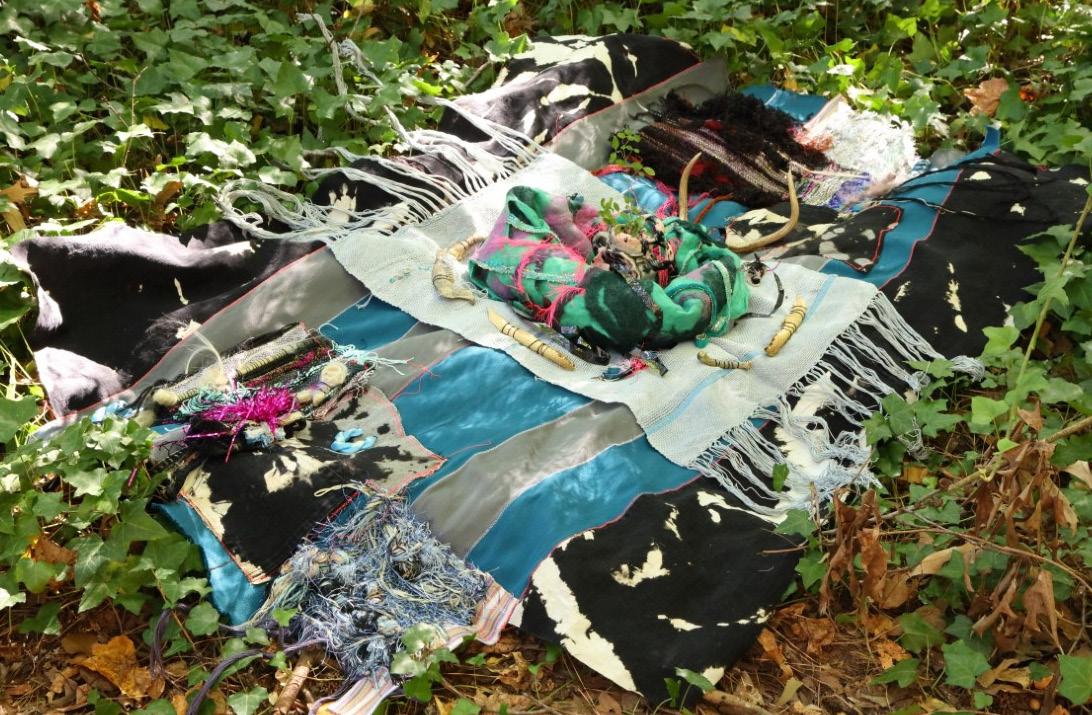
“Looming Chaos” is a solo exhibition of Atlantabased artist Zipporah Camille Thompson. The exhibition explores the artist’s use of weaving to engage ideas of chaos. Thompson conceptualizes chaos as the tensions associated with personal and universal experiences of disaster and catastrophe. Her weaving practice enables her to materialize the destruction, disorder, and confusions of the world, transforming them into fantastical fiber abstractions. The deterioration of the environment, tumultuous personal histories, and the complexities of her own identity become fodder for creation. •
Image, left page, top: Sam Gilliam, Untitled, 1970. Courtesy of Clark Atlanta University Art Museum. Left page, bottom: mutant, 2016. Courtesy of Zipporah Camille Thomson and the Zuckerman Museum of Art.
Image, this page, top: azul electrica (electric blue), 2019. Courtesy of Zipporah Camille Thomson. Image, this page, bottom: Romare Bearden, detail, Snow Morning, 1959.
All photography by Mike Jensen, courtesy of the Zuckerman Museum of Art.

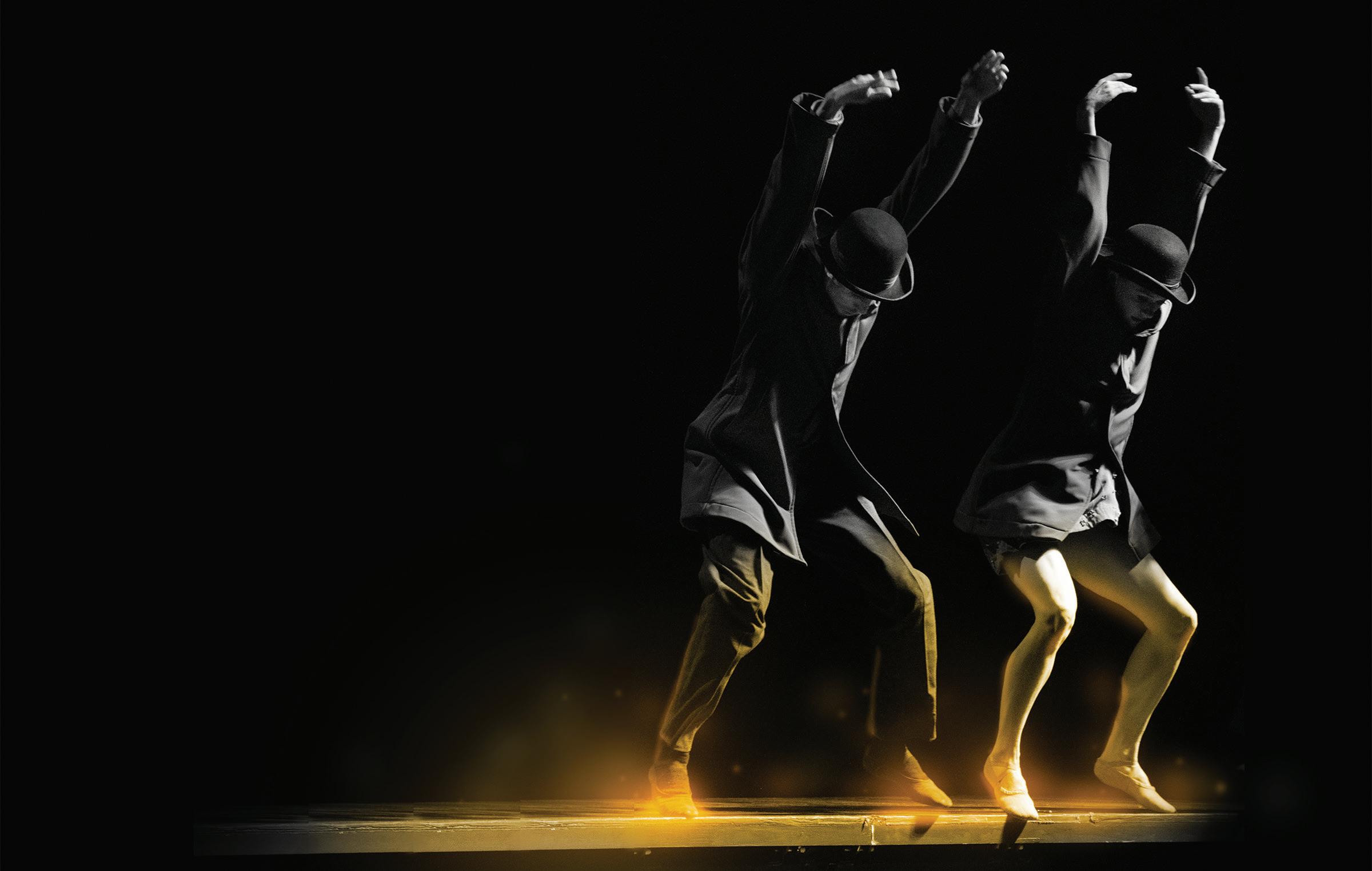
In 2019-2020, the Department of Dance hosted both Charlotte Ballet and Terminus Modern Ballet Theatre. McCree O’Kelley, interim chair of the Department of Dance, said, “We were thrilled to share these nationallyranked companies with both our students and metro Atlanta audiences. The Department of Dance at Kennesaw State University is committed to exposing our students and audiences to cutting-edge dance. KSU Dance is distinguished by our state-of-the-art Dance Theater, community partnerships and our commitment to engage with the professional practice.”
A world-class repertory dance ensemble based in Charlotte, N.C., Charlotte Ballet performs classic and contemporary dance with virtuosity, energy, and artistic excellence for local, statewide and national audiences. Charlotte Ballet’s collective talents challenge, stimulate, educate, entertain, and enrich audiences.
In September 2019, the ensemble took the stage of the KSU Marietta Dance Theater to present “Walking Mad” and “Redbird.” Choreographer Myles Thatcher’s abstract piece “Redbird” echoed the choreographer’s own struggle with grief and loss while having, as one reviewer put it, “a gorgeous ritualistic tableau.” Acclaimed choreographer Johan Inger’s “Walking Mad” followed “Redbird” and showcased breathtaking beauty, boundless energy and amazing athleticism.
Under the artistic direction of Hope Muir, Charlotte Ballet (formerly known as North Carolina Dance Theatre) has received national recognition for their classical and contemporary repertory featuring the choreography of artists from around the world.
With the goal of assembling a group of dancers who focus on telling stories through dance, alumnus John Welker (Dance, ‘17) started
Terminus Modern Ballet Theater (Terminus). KSU Dance hosted Terminus in March 2020 as they presented “Modern Myths.” An original production, “Modern Myths” demonstrates that “you don’t have to go to New York City to experience world-class arts programming,” according to Welker.
An evening of neo-classical ballet inspired by the legends of Greek mythology, “Modern Myths” featured the Atlanta premiere of Terminus resident choreographer Tara Lee’s “Under the Olive Tree” and Terminus resident choreographer Heath Gill’s “Horizons.” An Atlanta premiere, “Under the Olive Tree” first premiered with New Orleans Ballet Theater in 2016. Called “stark,” “striking,” and “sensual” by the Miami Herald, Lee’s fluid choreography both celebrates and opposes classicism, and is inspired by the divine/human duality of the Greek gods and goddesses. The work featured

Peng Yu Chen, formerly with Atlanta Ballet, and Terminus School students, making it the largest cast to date.
Terminus and KSU Dance announced their partnership in Fall of 2019; this production was the first Terminus performance hosted by KSU since establishing the partnership. O’Kelley said.
“We are thrilled we were able to bring these innovative companies to campus and give our students the opportunity to witness these inspiring artists.” •
Photo, left: “Walking Mad” courtesy of Charlotte Ballet. Photo, top: “Modern Myths” courtesy of Terminus Modern Ballet Theatre.
Art and Design students, faculty, & alumni Throw For A Cause Bowls thrown, glazed, and fired for Empty Bowls Project
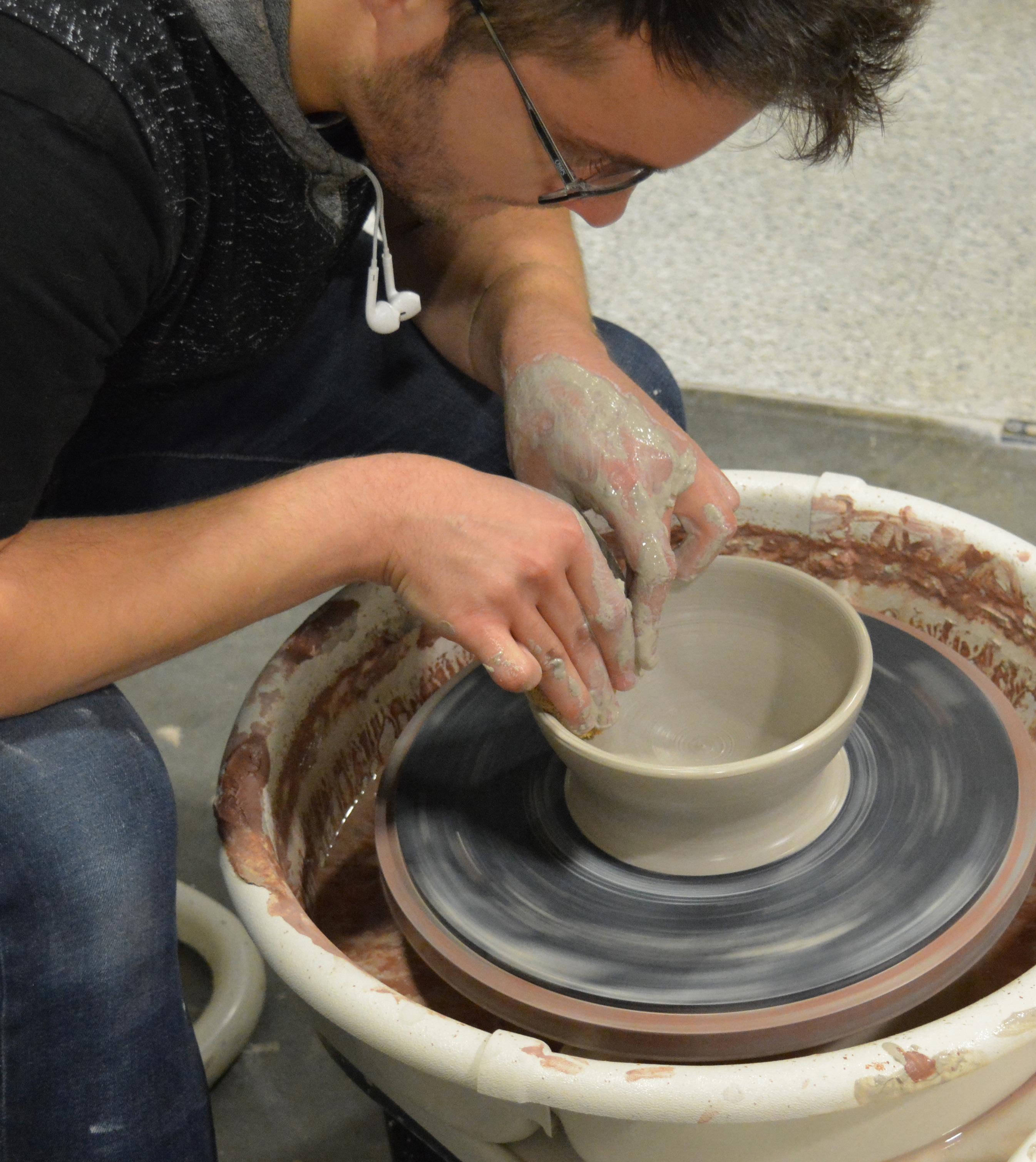
For the 12th annual Homelessness Awareness Week (HAW), Kennesaw State University’s (KSU) CARE Services partnered with the School of Art and Design (SOAAD) and University Dining to bring the Empty Bowls Project back for its third year as part of the HAW lineup. The annual fundraising event helps KSU CARE services fight hunger and raise awareness about the issues of food insecurity; all proceeds go directly to CARE Services. KSU Mudslingers Ceramics club members, led by associate professors of Art Jeff Campana and Keith Smith, held a “throwa-thon” during the SOAAD Open House on October 24, 2019. Participants threw, glazed, and fired 75 bowls for the Empty Bowls Project. Campana also assigned this project to his wheelthrowing class, where students created two bowls each, bringing in another 50 bowls for the event. Campana also made an additional 25 on his own to bring the total amount of bowls for the event to 150. By Lauren Richmond
“In addition to the charitable cause,” says Campana, “there is a valuable experience for students to make work and put it in the public realm. They had the opportunity to fire in all of the varieties that our studio can offer, that were suitable for the function.”

Each attendee selected their own handcrafted bowl, which was promptly filled with vegan soup, made from local, seasonal produce. While enjoying the meal, patrons heard from guest speakers on sustainability and food insecurity. Speakers included a student representative of CARE Services as well as representatives from Forerunner Foods, University Dining, the Office of Sustainability, and SOAAD. Attendees proudly carried their bowls home as a reminder of the event; all proceeds went directly to CARE Services.
“The purpose of this event,” said Kim Henghold of the Office of Community Engagement, “is two-fold: creating awareness around food insecurity and homelessness and creating a fundraising opportunity for CARE Services. It is such a unique event because the attendees are able to learn, feel good about their donation, and walk away with a beautiful piece of art that we hope reminds the participants of the issues presented.” •
KSU Dance senior rehearses renowned dance company Hard work pays off with important professional opportunity

Kennesaw State University (KSU) senior Shari Purnell gained critical professional experience in January when Department of Dance Professor Thang Dao invited Purnell to assist him in staging Roked for Philadelphia Dance Company (Philadanco) in New York City for their upcoming season and tour. In fall of 2019, Roked was performed by a cast of 17 dancers from the KSU Dance Company, in which Purnell was a soloist.
Each fall semester, Dance faculty choreograph works for students to learn and perform, and Prof. Dao choreographed Roked as part of the production SLANG. Purnell proved to be skilled at not only learning how to analyze movements, but also how to decipher movements to teach fellow dancers. “During our rehearsals,” she says, “Professor Dao tasked me with retaining choreography and teaching parts.” Prof. Dao has a history with Philadanco, regularly working with them over the past several years, and when they asked him to set a new work for their upcoming season, Roked was an obvious choice, and he enlisted Purnell as his rehearsal assistant.
“Philadanco’s dancers are a miracle of skill and energy,” writes Dance Magazine. “They work in a range of idioms most companies don’t even try to possess…a company that can do more than anything. It can represent the human spirit through dance.” Purnell knew this was an exciting and challenging opportunity. “I was scared at first,” she reflects. “The first day, my voice was shaking as a tried to teach, but the dancers were really nice. We
loosened up and every day turned out to be so much fun.” While the experience in and of itself was quite the opportunity for a dance student, one aspect stuck out to Purnell: “I think the professional development side of it was really exciting for me. I tend to be really nervous about getting out there to meet companies and network, so I feel like that gave me a chance to develop something before I graduate: a relationship with a company that I could possibility work with in the future.”
“I think I’ve gained more confidence,” she says of her Philadanco experience. “I’m still nervous here and there, but being in that experience where I knew the information and knew how to teach it, there was no doubt that I was going to deliver. I didn’t always think that, but I now have more confidence to tell myself ‘no, I know how to do this,” and realize I can bring value to someone’s company.” This confidence has been developing over the course of her studies at KSU and this experience with a professional dance company cemented that growth. “I’ve seen over my time here at KSU,” she says, “that the [Dance] department has really put an emphasis on professionalism that we need after we graduate. That has been really important to me.”
“You have to believe in yourself,” she advises aspiring dancers. “If you don’t believe in yourself, no one else will. You have to put that in if you want to continue, and those around you will see if you don’t believe in yourself. Be your biggest fan and
advocate.” •






